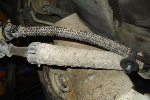TequilaSnrs087
Well-Known Member
- Joined
- September 17, 2007
- Messages
- 109
- Reaction score
- 0
- City, State
- Chapel Hill/Charlotte, NC
- Year, Model & Trim Level
- '95 Sport
A while back I started noticing a coolant smell coming from my 1995 4.0 Sport. I popped the hood and saw very slight coolant seepage from the part of the radiator where the transmission cooler lines screw in. Nothing ever dripped to the ground, and it was such a tiny amount of coolant that I decided to leave it alone. A couple days ago I noticed that the coolant level was a little low in the resivoir. Not by much at all - just a little. I topped it off anyway so I could monitor the change in the level. Today I checked it and it was back to the same level it was at a couple days before. I also noticed coolant on the coil pack and on the connector for one of the fuel injectors. There was also a drop or two on that heater valve thing just to the left of the coil pack. I looked and could see that there was some coolant resting on the top of the lower intake manifold. I decided to go ahead and buy a gasket set. I checked it again later and everything was dry. No trace of coolant at all. This was after maybe 80 miles of driving. The resivoir level was the same when I checked again. So where could this coolant be coming from? How is it getting on top of the coil pack when that is above the intake? Could the heater valve be spashing coolant on to the engine? If it helps, the place that changed the oil last said they saw some coolant on the passenger side lower control arm. I assumed it had splashed out of the resivoir.
Also, if I do have to replace the intake gaskets, what should I expect? I have done some minor work before, but not intake manifold gaskets. Hayne's says you have to remove the valve covers to get the lower intake manifold off...is this true? If so, are there any tricks for getting that bracket that holds the coil pack unbolted from the exhaust manifold? Also, everything below the lower intake manifold is very dry with so signs of leaks, but I don't think there are coolant passages in the upper composite manifold that could leak coolant on to the lower intake manifold. Is this correct?
BTW - when I checked it this morning and saw the coolant, the heat had been on. When I checked it later and saw no coolant, the heat had been off...the HVAC was switched to blow in cool outside air. Sound like it might be related to that coolant valve?
Also, if I do have to replace the intake gaskets, what should I expect? I have done some minor work before, but not intake manifold gaskets. Hayne's says you have to remove the valve covers to get the lower intake manifold off...is this true? If so, are there any tricks for getting that bracket that holds the coil pack unbolted from the exhaust manifold? Also, everything below the lower intake manifold is very dry with so signs of leaks, but I don't think there are coolant passages in the upper composite manifold that could leak coolant on to the lower intake manifold. Is this correct?
BTW - when I checked it this morning and saw the coolant, the heat had been on. When I checked it later and saw no coolant, the heat had been off...the HVAC was switched to blow in cool outside air. Sound like it might be related to that coolant valve?










